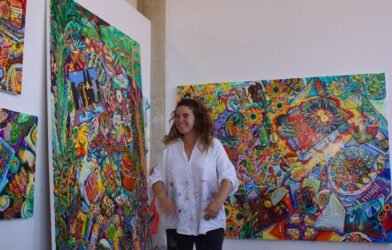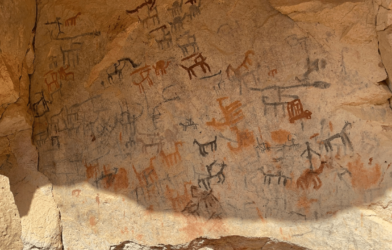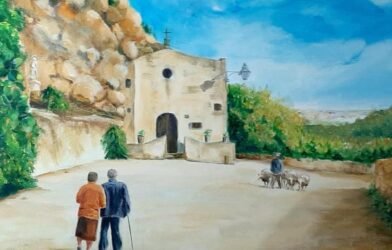Since 1895 La Biennale di Venezia (the Venice Biennale) has been the world’s foremost art exhibition and Agnes Waruguru is the only Kenya at this year’s show.
Held every two years in Venice, Italy, the 60th edition of the Biennale runs from April to November. Over 800,000 people visited the exhibition in 2022.
“It’s incredible to be part of such a huge history, where everyone is looking to see what is happening in the contemporary art world,” said Waruguru.
Works of over 300 international artists are featured in the main Arsenale and Giardini exhibit areas, and more are on display in pavilions around the island.
Sixteen African countries are present, with Tanzania, Ethiopia and Senegal participating for the first time.
Kenya does not have a national pavilion this year.
“Being chosen for such a long and important event is really humbling,” said 30-year-old Waruguru.
The exhibition’s curator, she believes, was making a statement that one does not need a massive career or a great deal of resources to feature at the Biennale. “It shows that what is most important is dedication to practice.”
The invitation happened rather quickly for Waruguru. Adriano Pedrosa, the curator of the 2024 Venice Biennale, had been travelling around the world in 2023 conducting studio visits and meeting artists whose practice interested him.
However, when he visited Kenya in 2023 Waruguru was at a two-year arts residency at the Rijksakademie van Beeldende Kunsten (National Academy of Fine Arts) in the Netherlands. Fortunately, they met later in the year in Sao Paulo city, Brazil, Pedrosa’s home country and where she was showcasing her textiles at the Videobrazil Biennale.

Kenyan artist Agnes Waruguru stands next to her Incomprehensible Weather in the Head installation during the 2024 Biennale exhibition in Vienna in April.
Photo credit: Photo | Pool
Then in October Waruguru received an invitation to participate, quite short notice for such an enormous exhibition. However, she managed to conceptualise and prepare new art pieces in time for the opening.
Waruguru has previously visited the Venice Biennale, but attending the inaugural week in April 2024 as a participating artist was an extraordinary and exciting experience, she said, especially after focusing for months on making the work and how the installation would happen.
“It is incredible how many people care [about art] and want to participate in these events,” said Waruguru.
Waruguru is known for minimalist paintings on textiles, especially everyday fabrics like cotton. “I want to create a closeness to my work instead of it being intimidating or bravado,” she explained.
Her practice explores ideas of home, time and weaving through places, often drawn from her experiences of living abroad which invoked a sense of displacement and being out of touch with her roots.
“I was interested in how to communicate ordinary life and family, and textiles were an immediate way to talk about this,” she said.
Typically, she uses old bedsheets, kangas, sheer curtains and other household fabrics directly related to Kenya. As part of building rituals around her practice, Waruguru employs organic paints made from hibiscus tea, turmeric, saffron and other natural materials. Her art medium draws from common kitchen ingredients and ‘memoryscapes’ of childhood such as her mother treating colds with a ginger-turmeric mix.
Waruguru’s installation at the Arsenale venue is called Incomprehensible Weather in the Head. Eight panels of white cloth, between four to eight feet long, hang from the ceiling and occasionally sway in a gentle, calming movement. They are painted with abstract splashes of colour, florals and squiggles, with embroidery, beads and netting.
“I’m happy to put work out there using local materials and beadwork made by local women artisans,” said Waruguru. Behind the art-making, she says, is pride in the material culture of Kenya, its history, its origins “and what’s going on with it.”
Her art explores a particular space and geography but from different perspectives, “knowing that it will be different with each person who interacts with my work.”
A recent inspiration was the book Vagabonds by Nigerian author, Eloghosa Osunde, short stories about different vagrants in Lagos and which inspired the title of her Venice Biennale artwork. Waruguru was struck by how the novel’s characters negotiate the same city through different perceptions and merge spirituality into everyday life.
Incomprehensible Weather in the Head refers to “navigating many spaces all at once, through many motions, and not quite being able to grasp everything,” she said. The overall theme of the 60th Biennale, Foreigners Everywhere, was particularly meaningful to her, having lived in different countries and traversed through many new spaces.
Born and raised in Kenya, Waruguru was interested in art as a child but it was not taught as a subject in primary school. Fortunately, an interior designer and friend of her mother noticed her love of drawing.
“She gave me some art classes and from there I was obsessed with it,” she said, adding that art has saved her life in many ways. “It keeps me curious, keeps me learning and gives me purpose in a much bigger way than I can express in words.”
Her advice to young people interested in pursuing an art career is, “If it’s something you really care deeply about, keep at it. Today there are more options for creative careers than there has ever been.”
Waruguru’s work has been exhibited in Kenya, France, the Netherlands and the US. She is preparing for a solo show at Circle Art Gallery, Nairobi later in 2024 and group shows in the Netherlands and Los Angeles.









